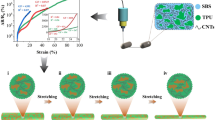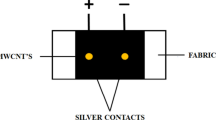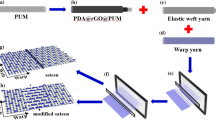Abstract
In this study, a flexible highly sensitive strain sensor was fabricated using thermoplastic polyurethane (TPU) and carbonized woven fabric based on polyacrylonitrile nanofiber yarn (PNY). The carbonized PNY fabric was prepared according to the following steps: filaments fabricated by electro spinning were twisted into a yarn; the yarn was treated by a sizing agent and weaved as a weft yarn; subsequently, the woven fabric was washed, pressed, and dried; finally, the carbonized PNY woven fabric was obtained through stabilization and carbonization. The effects of the thickness of the TPU film and the structure of the fabric on the sensing properties are discussed. The flexible strain sensor exhibits excellent sensitivity in the high-sensing strain range (average gauge factor = 77.3 within 12% strain) and high durability and stability (more than 1000 stretching cycles at 5% strain). Moreover, the strain sensor exhibits an excellent linear relationship between the strain and relative resistance change and accurately detects a full range of human activities (both vigorous and subtle). Such flexible highly sensitive strain sensors can be easily incorporated onto the surfaces of textiles and within electronics for use in various applications, toward applications such as smart textiles and health monitoring.






Similar content being viewed by others
References
Chen S, Liu S, Wang P, Liu H, Liu L (2018) Highly stretchable fiber-shaped e-textiles for strain/pressure sensing, full-range human motions detection, health monitoring, and 2D force mapping. J Mater Sci 53:2995–3005. https://doi.org/10.1007/s10853-017-1644-y
Yang TT, Jiang X, Zhong YJ, Zhao XL, Lin SY, Li J, Li XM, Xu JL, Li ZH, Zhu HW (2017) A wearable and highly sensitive graphene strain sensor for precise home-based pulse wave monitoring. ACS Sensors 2:967–974
Park JJ, Hyun WJ, Mun SC, Park YT, Park OO (2015) Highly stretchable and wearable graphene strain sensors with controllable sensitivity for human motion monitoring. ACS Appl Mater Interfaces 7:6317–6324
Pang Y, Tian H, Tao LQ, Li YX, Wang XF, Deng NQ, Yang Y, Ren TL (2016) Flexible, highly sensitive, and wearable pressure and strain sensors with graphene porous network structure. ACS Appl Mater Interfaces 8:26458–26462
Ryu S, Lee P, Chou JB, Xu RZ, Zhao R, Hart AJ, Kim SG (2015) Extremely elastic wearable carbon nanotube fiber strain sensor for monitoring of human motion. ACS Nano 9:5929–5936
Georgousis G, Pandis C, Chatzimanolis-Moustakas C, Kyritsis A, Kontou E, Pissis P, Krajci J, Chodak I, Tabaciarova J, Micusik M, Omastova M (2015) Study of the reinforcing mechanism and strain sensing in a carbon black filled elastomer. Compos Part B-Eng 80:20–26
Suzuki K, Yataka K, Okumiya Y, Sakakibara S, Sako K, Mimura H, Inoue Y (2016) Rapid-response, widely stretchable sensor of aligned MWCNT/elastomer composites for human motion detection. ACS Sensors 1:817–825
Li Y, Samad YA, Taha T, Cai GW, Fu SY, Liao K (2016) Highly flexible strain sensor from tissue paper for wearable electronics. ACS Sustain Chem Eng 4:4288–4295
Wang F, Liu S, Shu L, Tao XM (2017) Low-dimensional carbon-based sensors and sensing network for wearable health and environmental monitoring. Carbon 121:353–367
Hrovat M, Belavic D, Samardzija Z (2001) Characterisation of thick film resistor series for strain sensors. J Eur Ceram Soc 21:2001–2004
Barlian AA, Park WT, Mallon JR, Rastegar AJ, Pruitt BL (2009) Semiconductor piezoresistance for microsystems. Proc IEEE 97:513–552
Jian MQ, Wang CY, Wang Q, Wang HM, Xia KL, Yin Z, Zhang MC, Liang XP, Zhang YY (2017) Advanced carbon materials for flexible and wearable sensors. Sci China Mater 60:1026–1062
Farcau C, Moreira H, Viallet B, Grisolia J, Ciuculescu- Pradines D, Amiens C, Ressier L (2011) Monolayered wires of gold colloidal nanoparticles for high-sensitivity strain sensing. J Phys Chem C 115:14494–14499
Amjadi M, Pichitpajongkit A, Lee S, Ryu S, Park I (2014) Highly stretchable and sensitive strain sensor based on silver nanowire–elastomer nanocomposite. ACS Nano 8:5154–5163
Gong S, Schwalb W, Wang YW, Chen Y, Tang Y, Si J, Shirinzadeh B, Cheng WL (2014) A wearable and highly sensitive pressure sensor with ultrathin gold nanowires. Nat Commun 5:3132
Yu Y, Luo YF, Guo A, Yan LJ, Wu Y, Jiang KL, Li QQ, Fan SS, Wang JP (2017) Flexible and transparent strain sensors based on super-aligned carbon nanotube films. Nanoscale 9:6716–6723
Zhao HB, Zhang YY, Bradford PD, Zhou Q, Jia QX, Yuan FG, Zhu YT (2010) Carbon nanotube yarn strain sensors. Nanotechnology 21:305502
Zhou J, Yu H, Xu XZ, Han F, Lubineau G (2017) Ultrasensitive, stretchable strain sensors based on fragmented carbon nanotube papers. ACS Appl Mater Interfaces 9:4835–4842
Li JH, Zhao SF, Zeng XL, Huang WP, Gong ZY, Zhang GP, Sun R, Wong CP (2016) Highly stretchable and sensitive strain sensor based on facilely prepared three-dimensional graphene foam composite. ACS Appl Mater Interfaces 8:18954–18961
Tang YC, Zhao ZB, Hu H, Liu Y, Wang XZ, Zhou SK, Qiu JS (2015) Highly stretchable and ultrasensitive strain sensor based on reduced graphene oxide microtubes-elastomer composite. ACS Appl Mater Interfaces 7:27432–27439
Wu XD, Lu CH, Han YY, Zhou ZH, Yuan GP, Zhang XX (2016) Cellulose nanowhisker modulated 3D hierarchical conductive structure of carbon black/natural rubber nanocomposites for liquid and strain sensing application. Compos Sci Technol 124:44–51
Yin B, Wen YW, Hong T, Xie ZS, Yuan GL, Ji QM, Jia HB (2017) Highly stretchable, ultrasensitive, and wearable strain sensors based on facilely prepared reduced graphene oxide woven fabrics in an ethanol flame. ACS Appl Mater Interfaces 9:32054–32064
Liu X, Tang C, Du XH, Xiong S, Xi SY, Liu YF, Shen X, Zheng QB, Wang ZY, Wu Y, Horner A, Kim JK (2017) A highly sensitive graphene woven fabric strain sensor for wearable wireless musical instruments. Mater Horiz 4:477–486
Amjadi M, Kyung KU, Park I, Sitti M (2016) Stretchable, skin-mountable, and wearable strain sensors and their potential applications: a review. Adv Funct Mater 26:1678–1698
Wu XD, Han YY, Zhang XX, Lu CH (2016) Highly sensitive, stretchable, and wash-durable strain sensor based on ultrathin conductive layer@ polyurethane yarn for tiny motion monitoring. ACS Appl Mater Interfaces 8:9936–9945
Yan CY, Wang JX, Kang WB, Cui MQ, Wang X, Foo CY, Chee KJ, Lee PS (2014) Highly stretchable piezoresistive graphene-nanocellulose nanopaper for strain sensors. Adv Mater 26:2022–2027
Zhu JH, Wei SY, Ryu J, Guo ZH (2011) Strain-sensing elastomer/carbon nanofiber “Metacomposites”. J Phys Chem C 115:13215–13222
Wang X, Sparkman J, Gou J (2017) Strain sensing of printed carbon nanotube sensors on polyurethane substrate with spray deposition modeling. Comp Comm 3:1–6
Georgousis G, Pandis C, Kalamiotis A, Georgiopoulos P, Kyritsis A, Kontou E, Pissis P, Micusik M, Czanikova K, Kulicek J, Omastova M (2015) Strain sensing in polymer/carbon nanotube composites by electrical resistance measurement. Compos Part B-Eng 68:162–169
Darbandi SMA, Nouri M, Mokhtari J (2012) Electrospun nanostructures based on polyurethane/MWCNTs for strain sensing applications. Fiber Polym 13:1126–1131
Wang B, Lee BK, Kwak MJ, Lee DW (2013) Graphene/polydimethylsiloxane nanocomposite strain sensor. Rev Sci Instrum 84:105005
Lee C, Jug L, Meng E (2013) High strain biocompatible polydimethylsiloxane-based conductive graphene and multiwalled carbon nanotube nanocomposite strain sensors. Appl Phys Lett 102:183511
Liu Q, Chen J, Li YR, Shi GQ (2016) high-performance strain sensors with fish-scale-like graphene-sensing layers for full-range detection of human motions. ACS Nano 10:7901–7906
Boland CS, Khan U, Backes C, O’Neill A, McCauley J, Duane S, Shanker R, Liu Y, Jurewicz L, Dalton AB, Coleman JN (2014) Sensitive, high-strain, high-rate bodily motion sensors based on graphene-rubber composites. ACS Nano 8:8819–8830
Li YB, Shang YY, He XD, Peng QY, Du SY, Shi EZ, Wu ST, Li Z, Li PX, Cao AY (2013) Overtwisted, resolvable carbon nanotube yarn entanglement as strain sensors and rotational actuators. ACS Nano 7:8128–8135
Wang ZF, Huang Y, Sun JF, Huang Y, Hu H, Jiang RJ, Li GM, Zhi CY (2016) Polyurethane/cotton/carbon nanotubes core-spun yarn as high reliability stretchable strain sensor for human motion detection. ACS Appl Mater Interfaces 8:24837–24843
Zhang R, Deng H, Valenca R, Jin JH, Fu Q, Bilotti E, Peijs T (2012) Carbon nanotube polymer coatings for textile yarns with good strain sensing capability. Sens Actuat A Phys 179:83–91
Li XT, Hua T, Xu B (2017) Electromechanical properties of a yarn strain sensor with graphene-sheath/polyurethane-core. Carbon 118:686–698
Deng CH, Pan LJ, Cui RX, Li CW, Qin J (2017) Wearable strain sensor made of carbonized cotton cloth. J Mater Sci-Mater Electron 28:3535–3541. https://doi.org/10.1007/s10854-016-5954-7
Wang CY, Li X, Gao EL, Jian MQ, Xia KL, Wang Q, Xu ZP, Ren TL, Zhang YY (2016) Carbonized silk fabric for ultrastretchable, highly sensitive, and wearable strain sensors. Adv Mater 28:6640–6648
Zhang MC, Wang CY, Wang HM, Jian MQ, Hao XY, Zhang YY (2017) Carbonized cotton fabric for high-performance wearable strain sensors. Adv Funct Mater 27:1604795
Wang CY, Xia KL, Jian MQ, Wang HM, Zhang MC, Zhang YY (2017) Carbonized silk georgette as an ultrasensitive wearable strain sensor for full-range human activity monitoring. J Mater Chem C 5:7604–7611
Ren JS, Wang CX, Zhang X, Carey T, Chen KL, Yin YJ, Torrisi F (2017) Environmentally-friendly conductive cotton fabric as flexible strain sensor based on hot press reduced graphene oxide. Carbon 111:622–630
Moriche R, Jiménez-Suárez A, Sánchez M, Prolongo SG, Ureña A (2017) Graphene nanoplatelets coated glass fibre fabrics as strain sensors. Compos Sci Technol 146:59–64
Lee H, Glasper MJ, Li X, Nychka JA, Batcheller J, Chung HJ, Chen Y (2018) Preparation of fabric strain sensor based on graphene for human motion monitoring. J Mater Sci 53:9026–9033. https://doi.org/10.1007/s10853-018-2194-7
Wang Y, Wang L, Yang TT, Li X, Zang XB, Zhu M, Wang KL, Wu DH, Zhu HW (2014) Wearable and highly sensitive graphene strain sensors for human motion monitoring. Adv Funct Mater 24:4666–4670
Foroughi J, Spinks GM, Aziz S, Mirabedini A, Jeiranikhameneh A, Wallace GG, Kozlov ME, Baughman RH (2016) Knitted carbon-nanotube-sheath/spandex-core elastomeric yarns for artificial muscles and strain sensing. ACS Nano 10:9129–9135
Guo FM, Cui X, Wang KL, Wei JQ (2016) Stretchable and compressible strain sensors based on carbon nanotube meshes. Nanoscale 8:19352–19358
Li X, Zhang R, Yu WJ, Wang KL, Wei JQ, Wu DH, Cao AY, Li ZH, Cheng Y, Zheng QS, Ruoff RS, Zhu HW (2012) Stretchable and highly sensitive graphene-on-polymer strain sensors. Sci Rep 7:870
Yan T, Tian L, Pan ZJ (2016) Structures and mechanical properties of plied and twisted polyacrylonitrile nanofiber yarns fabricated by a multi-needle electrospinning device. Fiber Polym 17:1627–1633
Yan T, Pan ZJ (2018) Structures and properties of polyacrylonitrile/graphene composite nanofiber yarns prepared by multi-needle electrospinning device with an auxiliary electrode. J Nanosci Nanotechnol 18:4255–4263
Yan T, Pan ZJ (2017) High conductivity electrospun carbon/graphene composite nanofiber yarns. Polym Eng Sci. https://doi.org/10.1002/pen.24643
Zhou J, Xu X, Yu H, Lubineau G (2017) Deformable and wearable carbon nanotube microwire-based sensors for ultrasensitive monitoring of strain, pressure and torsion. Nanoscale 9:604–612
Acknowledgements
Financial support for this work was provided by Nantong Science and Technology Program Project (Grant Number GY12016025), the Priority Academic Program Development of the Jiangsu Higher Education Institutions and Postgraduate Research and Practice Innovation Program of Jiangsu Province (Grant Number KYCX17-1985).
Author information
Authors and Affiliations
Corresponding author
Ethics declarations
Conflict of interest
The authors have no conflict of interest to declare.
Electronic supplementary material
Below is the link to the electronic supplementary material.
Rights and permissions
About this article
Cite this article
Yan, T., Wang, Z. & Pan, ZJ. A highly sensitive strain sensor based on a carbonized polyacrylonitrile nanofiber woven fabric. J Mater Sci 53, 11917–11931 (2018). https://doi.org/10.1007/s10853-018-2432-z
Received:
Accepted:
Published:
Issue Date:
DOI: https://doi.org/10.1007/s10853-018-2432-z




